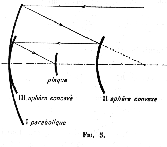Internal construction details - drawing by A.L.Woods
Internal construction details - drawing by A.L.Woods
1. An eccentric pupil. This can take the form of an eccentric stop placed at the mouth of the telescope, or a Newtonian can have the primary figured to an off-axis section of a paraboloid. Entire complex systems have been constructed in this manner, usually of all-spherical optics as any other design would be an optician's nightmare.
2. Tilt the primary to throw the image clear of incoming light. This approach is utilized in the Herschelian, the Yolo, the Schiefspiegler, and the Tri-Schiefspiegler telescopes. Tilting the primary introduces large aberrations into the image which must then be balanced out with compensating aberrations from subsequent elements.
3. Use an axially-symmetric telescope off-axis. This approach seldom works well as off-axis aberrations in telescopes are normally quite large to begin with. However, a little-known system by the French designer, Maurice Paul, frees a paraboloid of all third-order aberrations except for a gentle field curvature. This system, used off-axis, yields paraboloidal quality images throughout. The Stevick-Paul telescope would be just another tilted-component telescope were it not for this phenomenal perfection of its image.
The Stevick-Paul telescope (SPT) is one of just a few elegant optical systems and I prefer to think of it as a discovery rather than a design. It has aspects of the Mersenne telescope (two confocal paraboloids) and also of the Schmidt camera. All aberrations to the third-order total zero except for the Petzval surface which is gently curved. The present embodiment is in fact the third time this basic optical arrangement has been discovered.

The system was first described in 1935 by Maurice Paul
who presented it as a zero-power corrector for large astronomical
telescopes. The two spherical mirrors are of mating curve. Paul showed
the concave tertiary in contact with the paraboloidal primary. Because
of the large obstruction of this axial arrangement, Paul considered the
system of theoretical value only.
Dr. J.G.Baker independently rediscovered the Paul system in the 1960s. He moved the two spherical mirrors farther from the primary which reduces their diameter and obstruction, a condition allowed for by Paul's equations, but his chief contribution was to add an approximate fifth-order correction by turning the edge of the convex secondary. Since then these designs have been known as Baker-Paul three-mirror systems.
In 1991, as my computer program to raytrace tilted-component telescopes (TCTs) was nearing final polish, I began searching for an improved Tri-Schiefspiegler design. By varying radii and spacing I systematically explored a variety of designs. One particular spacing change put parallel light between secondary and tertiary, a condition I felt was all wrong. Just to satisfy myself that this was indeed undesirable I proceeded to optimize the mirror tilts.
The results were not at all remarkable but curiosity led me to explore whether the parallel light would permit spacing changes between the second and third mirrors without the need to re-tilt them. Such was the case, but then I noticed that increases in this space were reducing both coma and astigmatism at the same time. When the sec.-tert. space became equal to the radius of the tertiary, all aberrations disappeared. (I should mention that both the second and third mirrors had by chance been given the same r.o.c.)
Spot diagrams which previously had been large blurs collapsed to single dots, unbelievable! It was a week before I accepted the results as valid, and more agonizing months passed while I assembled a prototype. Satisfied finally that what I had found was workable, I mailed the design to the Amateur Telescope Makers Journal.
Within days Dr. Richard Buchroeder responded confirming my work and pointing out that this telescope was an off-axis form of the Paul system. With his guidance I located Paul's original work and the more recent work of Dr. Baker. Since my design doesn't employ the turned edge of the Baker-Paul systems, Dr. Baker kindly allowed the design to be called the Stevick-Paul telescope.
It has come to my attention that a prior, independent, unpublished discovery of this system was made by German amateur Michael Brunn while exploring 4-mirror systems (Tetra-Schiefs - U.S. patent no. 5,142,417). Michael unfailingly uses binocular attachments while observing so ignored the system for lack of sufficient back focal length. Binocular attachments require 8 to 10 inches of in-travel for focusing.
| Stevick-Paul design manual |
Curator: Hartmut Frommert
[contact]
[Schiefspiegler Home]
[SEDS]